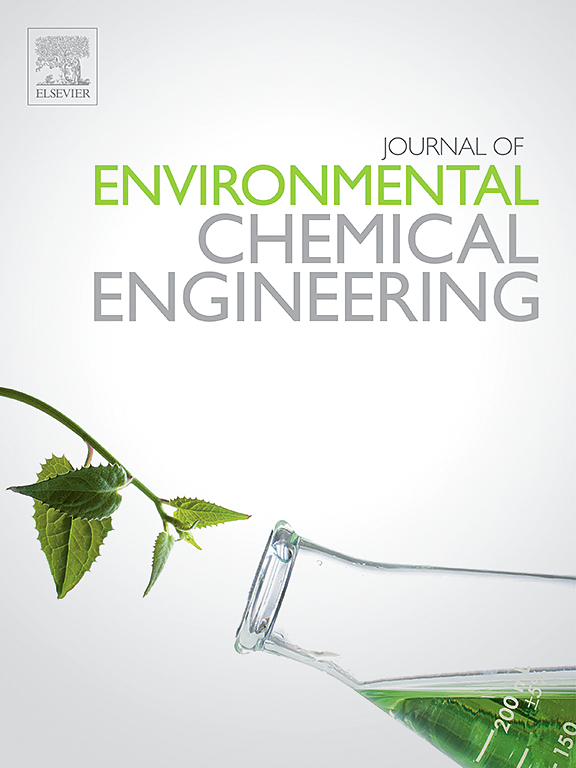Base metals (Ni, Cu, Zn, Fe) oxide nanomaterials mediated photo/sono-catalytic removal of emerging pharmaceutical contaminants from wastewater
IF 7.4
2区 工程技术
Q1 ENGINEERING, CHEMICAL
引用次数: 0
Abstract
Photo/sono-catalytic techniques are being extensively considered for the degradation and removal of emerging contaminants (EC), including pharma-based organic pollutants. Transition metal-based nanomaterials have been studied as adsorbent/catalytic material in photo/sono-catalytic techniques for complete elimination/degradation/mineralization of pharmaceutical-based EC from wastewater streams. Various structural properties with dimensionalities of earth-abundant base metals (Ni, Fe, Cu, and Zn) oxides and their doped hybrid/composites, have been recently studied for removal/degradation/mineralization of EC from solution on the laboratory scale and industrial effluent of pharma-sectors. The oxides of earth-abundant base metals nanomaterials have been summarised and discussed in this review along with the general mechanism of degradation/elimination with acceptable results related to wastewater stream detoxification and recyclability of catalytic material during degradation/removal of EC. The surface properties like transfer of electrons and holes, surface area, surface modification and doping with reusability value of these materials are primacy factors for their applicability in the degradation/removal of organic pollutants from wastewater and substantial treatment. This study would be helpful for their use and development of cutting-edge materials for waste/surface water treatment on a large scale in a sustainable and cost-effective manner.
基本金属(镍、铜、锌、铁)氧化物纳米材料介导的光催化/声催化去除废水中新出现的药物污染物
目前正在广泛考虑采用光催化/声催化技术来降解和去除新出现的污染物(EC),包括制药类有机污染物。研究人员已将过渡金属基纳米材料作为光催化/协同催化技术中的吸附/催化材料,用于彻底消除/降解/矿化废水中的制药基有机污染物。最近,人们研究了富土贱金属(镍、铁、铜和锌)氧化物及其掺杂杂化/复合材料的各种结构特性和尺寸,以便在实验室规模和制药行业工业废水中去除/降解/矿化溶液中的氨基甲酸乙酯。本综述总结并讨论了富土贱金属纳米材料的氧化物以及降解/去除的一般机理,并给出了与废水流解毒和催化材料在降解/去除氨基甲酸乙酯过程中的可回收性有关的可接受的结果。这些材料的表面特性,如电子和空穴的转移、表面积、表面改性和掺杂以及可再利用价值,是它们在降解/去除废水中的有机污染物和进行实质性处理时是否适用的首要因素。这项研究将有助于以可持续和具有成本效益的方式大规模使用和开发用于废物/地表水处理的尖端材料。
本文章由计算机程序翻译,如有差异,请以英文原文为准。
求助全文
约1分钟内获得全文
求助全文
来源期刊

Journal of Environmental Chemical Engineering
Environmental Science-Pollution
CiteScore
11.40
自引率
6.50%
发文量
2017
审稿时长
27 days
期刊介绍:
The Journal of Environmental Chemical Engineering (JECE) serves as a platform for the dissemination of original and innovative research focusing on the advancement of environmentally-friendly, sustainable technologies. JECE emphasizes the transition towards a carbon-neutral circular economy and a self-sufficient bio-based economy. Topics covered include soil, water, wastewater, and air decontamination; pollution monitoring, prevention, and control; advanced analytics, sensors, impact and risk assessment methodologies in environmental chemical engineering; resource recovery (water, nutrients, materials, energy); industrial ecology; valorization of waste streams; waste management (including e-waste); climate-water-energy-food nexus; novel materials for environmental, chemical, and energy applications; sustainability and environmental safety; water digitalization, water data science, and machine learning; process integration and intensification; recent developments in green chemistry for synthesis, catalysis, and energy; and original research on contaminants of emerging concern, persistent chemicals, and priority substances, including microplastics, nanoplastics, nanomaterials, micropollutants, antimicrobial resistance genes, and emerging pathogens (viruses, bacteria, parasites) of environmental significance.
 求助内容:
求助内容: 应助结果提醒方式:
应助结果提醒方式:


